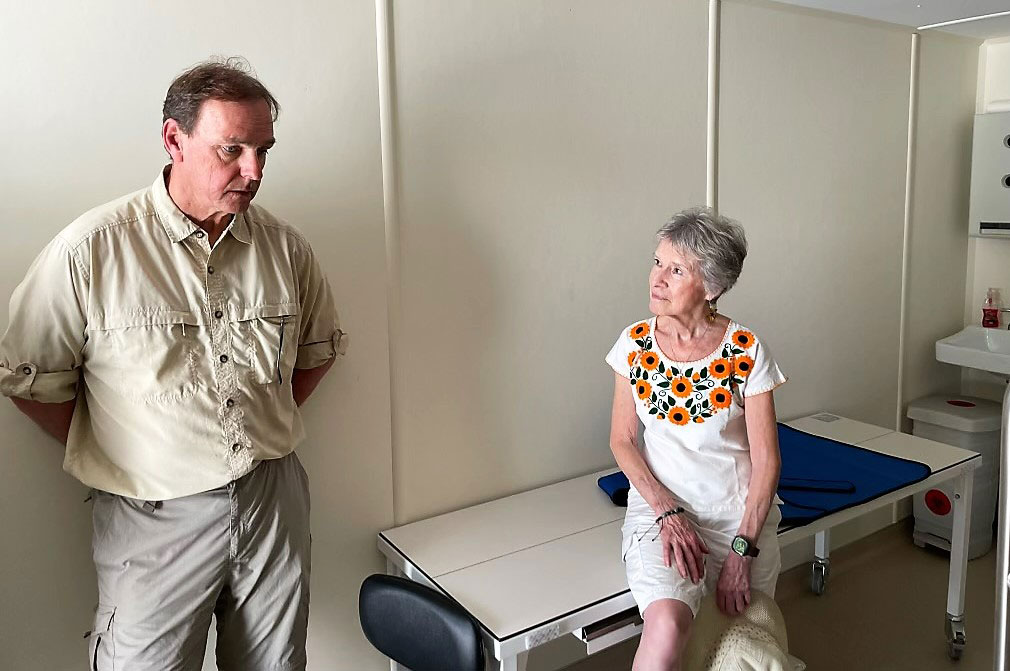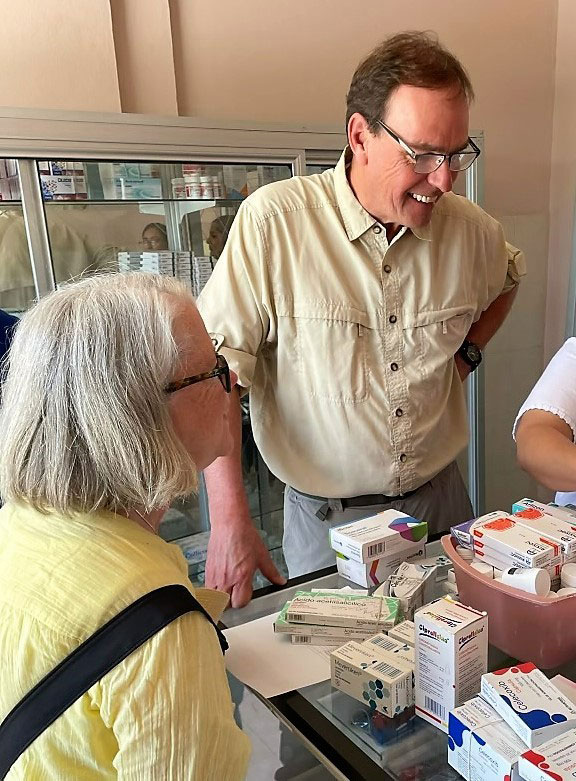
Doctors in Santa Maria travel to Palenque and assist with medical mission treating indigenous populations in Mexico
Physicians from the Santa Maria Women’s Health Center help patients some 3,000 miles from home working in a ‘Clinic in a Can’
 Doctors and staff from Dignity Health - Santa Maria Women’s Health Center have found themselves traveling nearly 3,000 miles to Palenque, a city in the Mexican state of Chiapas.
Doctors and staff from Dignity Health - Santa Maria Women’s Health Center have found themselves traveling nearly 3,000 miles to Palenque, a city in the Mexican state of Chiapas.
What exactly has drawn them there and how are they providing medical care in shipping containers?
OB/GYN physicians, Dr. Rebecca Jones and Dr. Brian Crisp along with Christi Perez, the clinic supervisor at Santa Maria Women’s Health Center, traveled to Palenque to assist with a medical mission started by the Sisters of St. Francis at a clinic that recently received a dazzling upgrade – prefabricated medical units, housed in shipping containers, that hold a laboratory and x-ray equipment among other modern features.
A mission to Palenque
 The Sisters of St. Francis, the same group that started Santa Maria’s Marian Regional Medical Center in the 1960s, helped open a medical clinic in Palenque nearly 30 years ago.
The Sisters of St. Francis, the same group that started Santa Maria’s Marian Regional Medical Center in the 1960s, helped open a medical clinic in Palenque nearly 30 years ago.
In November, Dr. Jones and Perez traveled to Palenque and saw patients at the clinic over five days; Jones in her capacity as a physician and Perez as an interpreter. Dr. Crisp visited the clinic last April, along with Dr. Jones, and has plans to see patients there in 2024.
Volunteer teams have gone on medical missions to help the people around Palenque since the clinic opened and the teams from the U.S. typically consist of doctors, medical residents, nurses, interpreters and maintenance workers.
Dr. Jones and Dr. Crisp are working to strengthen the relationship between the clinic in Palenque and the physicians and medical residents in Santa Maria.
Sister Maria Elena Martinez, a Santa Maria native and a major organizer behind the clinic, says the group has worked with 150 indigenous villages surrounding Palenque.
“There is a great need for medical help, especially for the women in village communities who don’t have access to healthcare – a lot of lives are at risk,” Sister Maria Elena says. “We have managed to get some physicians to go down to Palenque. We get medicine, get in a pickup and go to village communities and get them help.”
Clinic in a Can units bring upgrades
The clinic recently received the major upgrade that allows it to provide more services to those who visit the facility in Palenque.
“We had a dream and this dream showed us that we could save lives if we had a simple clinic where we could do minor procedures and that dream became a reality thanks to Dignity Health, which contributed to our purchasing of a ‘Clinic in a Can,’” Sister Maria Elena says.
The clinic, known as Clinica Familiar Lak ña Clara, has the motto: “Salud con Dignidad” (Health with Dignity) in honor of Dignity Health, the Sister said.
The ‘Clinic in a Can’ located at the compound is made up of pre-assembled shipping containers that house a laboratory, x-ray room, mother-infant units and consultation rooms. A surgical suite suffered major damage during transport to Palenque from the U.S. following a hurricane. The group hopes to gather the resources, through grants and donations, needed to get the surgical suite up and running.
The units have air conditioning and feature solar arrays to help power them.
Dedication to service attracts physicians
What, exactly, has drawn Dr. Jones and Dr. Crisp to the clinic in the remote city in the southern tip of Mexico?
“I’ve done a lot of volunteer work and I’m interested in providing care to marginalized people who are not getting the best care possible for a host of reasons – access, insurance, money, where they live,” Dr. Jones said. “That’s been a motivation for me for a long time.”
The trips to Palenque are, literally and figuratively, a two-way street. Of course, local doctors help the patients there, but they are also taking lessons learned in Palenque and applying them on the Central Coast of California, where there is a large indigenous Mexican population.
“We have a lot of problems taking good care of our Mixteco speakers (in Santa Maria). There’s a lack of trust and this leads to a lack of best practices,” Dr. Jones said. “Sometimes they don’t enroll early for care, they don’t follow our advice or they refuse interventions that we really feel are in their best interest. I really feel like this project, in particular, is a huge opportunity to improve that.”
Dr. Crisp was drawn to face the challenges of providing healthcare in Palenque by his sense of adventure.
“It’s a unique, fascinating and challenging area,” he said. “It’s steeped in Mayan culture and history. It’s really a fascinating place with archeological digs, Mayan temples and Mayan monuments. It’s stunning. This project is all the things Dr. Jones said and it’s set in an adventurous place.”
In her role as an interpreter, Perez said the experience in Palenque was rewarding.
“Knowing what their needs are and trying to help them was a nice experience,” Perez said. “Though, with just five days, it’s hard. Translating for the doctors was challenging and exhausting at times, but by the end of the day I was the one speaking English and Dr. Jones was the one speaking Spanish. It was a great experience, we loved it and it’d be a great idea to go back.”
What’s next in Palenque?
Doctors in Santa Maria, like Dr. Jones and Dr. Crisp, dream of establishing a program where local medical residents see patients in Palenque during yearly trips there.
“There’s paperwork that stands between us and bringing our residents and there’s also the scheduling,” Dr. Jones said. “We’ve just learned that there are requirements that OB/GYN residents go two weeks at a time, they cannot just go for one week, and that’s a lot of time for our kids. We have to really plan in advance, but I think we can accomplish that.”
Sister Maria Elena is hopeful that the surgical unit can get up and running.
“Fixing the surgical suite would allow us to have medical missions of surgeons from Marian Regional Medical Center and we’re eager to have residency students come down,” she said. “If we get the surgical suites working we could have medical surgeries three times a day. People need cataract surgeries, pterygium surgeries. For someone suffering blindness, all it takes is a quick operation.”
To learn more about the Santa Maria Women’s Health Center, click here.
